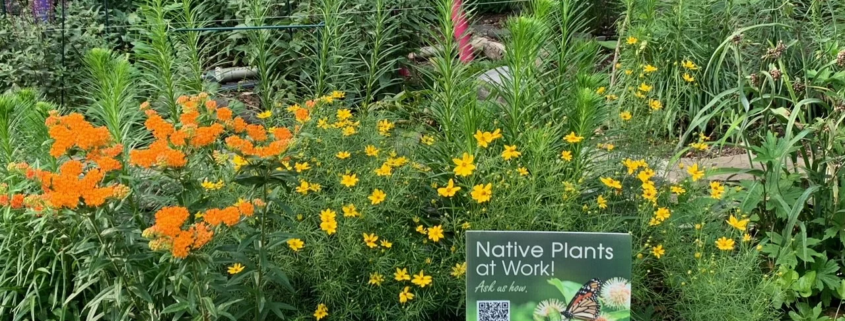Supporting Your Garden Through Heat and Drought
Photo and article by Plant NOVA Natives
We all know the climate is getting hotter. The week of July 22 included the world’s two hottest days in recorded history. At the same time, the average annual rainfall in Virginia has risen, as a warmer atmosphere tends to hold more moisture. Since it also creates more violent storms, the water runs off faster, a problem compounded by periods of drought. We can only anticipate more heat and more drought in the future.
These changes have not gone unnoticed by local gardeners. Some plants which had always seemed hardy are now struggling in the heat. We see some so-called “sun loving” plants wilting in the heat of direct sun and never fully recovering. We are not sure what “sun loving” really means at this point. How much direct sun do plants “love” when it’s 95 degrees?
Most plants require supplemental watering when newly planted, but this year even well-established and well-sited plants are struggling in the heat and drought. Native plants have the advantage of being adapted to our local conditions, but what happens when those conditions change? We asked our native plant gardeners to share observations about plants that normally tolerate full sun conditions. Here are some of their answers.
- Some redbuds in full sun that were fine in previous years are now turning brown, which makes sense as it is an understory species accustomed to at least some shade.
- Coral Honeysuckle is doing fine in full sun if the roots are shaded, which also mimics how the vine behaves in nature as it climbs up trees.
- Some Virgina Sweetspire shrubs are wilting under the full force of the afternoon sun.
- Green-and-gold seems to tolerate full sun or dry soil but not both. The same is true of Golden Ragwort.
- The shrubs Arrowwood and Black-haw viburnums, Spicebush, and Bladdernut seem unfazed.
- Examples of perennials and grasses that are holding up well despite the stress include asters, goldenrods, Tickseed Coreopsis, Butterfly Weed, Black-eyed Susan, Wild Petunia and Switchgrass. The plants may not grow as tall, though, when stressed.
Going forward, here are some gardening strategies to consider.
Shop for Drought-Resistant Plants: We can’t control the climate, but if we don’t want to spend the rest of our lives watering, we will shop more carefully for plants that tolerate heat and drought. A bit more research on the plant than the information provided by the plant label can pay off.
Consider Nature’s Place: Where plants are found in nature is a clue to where we should plant them. If they naturally grow in cooler, shadier, or wetter wild settings, they are likely to require more supplemental watering in a dryer, hotter garden. There are exceptions, though: some plants that grow in marshes, such as Buttonbush and Swamp Rose Mallow, do surprisingly well in compacted, clay soil.
Monitor Ground Moisture: Too much water can kill a plant as effectively as too little, so it is important to estimate the moisture level before watering. If sticking your finger into the ground doesn’t appeal, a moisture meter can be very handy and occasionally deliver some big surprises, since water moves down into even slight depressions.
Use Mulch: Two or three inches of hardwood or leaf mulch will cool the soil and reduce evaporation. However, too thick a layer can become a water barrier and actually dry out the bed. Wood chip mulch is the preferred choice under trees because water flows through it more easily. Fallen leaves are nature’s solution and can do the job in a garden bed with the additional benefit of providing habitat for fireflies and amphibians.
Plant Green Mulch: If you use living plants as a kind of green mulch, that can also cool and moisten the soil, though competition for water between plants needs to be considered.
Plant More Trees: With temperatures rising, shade gardens are the gardens of the future. Just remember that you should always pull turf grass away from tree trunks out to the drip line, since the roots of trees are quite shallow and have trouble competing with turf for water and nutrients.
Many answers to your questions can be found in the Plant NOVA Natives online search app, which we constantly update as more information comes in. If you have additional observations or strategies to contribute, please send them to plantnovanatives@gmail.com.


